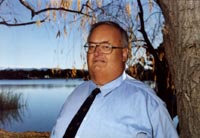
Looking Back - Big Achievements of the CRC for Freshwater Ecology
Peter Cullen
Foundation Chief Executive
To me the big scientific achievements of the CRC related to the scale
of our science, and the development of an experimental rather than a
descriptive approach to freshwater ecology.
One of the challenges from the beginning was to develop and implement a
means of assessing river health across States. While many people were
expressing concern about the degradation of our aquatic systems, we had
no means of doing large-scale assessments of river health.
The NSW Rivers Survey, led by John Harris and his team from NSW
Fisheries, was a groundbreaking study that assessed the health of fish
populations across the State. This showed that many rivers were
degraded; especially the more heavily managed Southern rivers of the
Murray. The
AUSRIVAS
tool developed by Richard Norris and his team, which used invertebrates
to assess river health, gave us an independent tool to make health
assessments. The ‘Snapshot’ of the Murray-Darling Basin and the River
Health Assessment for the
National Land and Water Resources Audit
were seminal products of the CRC. These two projects, involving many
CRC staff and outside collaborators, were fundamental in convincing the
Australian public that further work was needed in water reform, and
contributed to the current
National Water Initiative.
The Campaspe experimental flow project, conceived and developed by Sam
Lake and Paul Humphries, was designed to assess the environmental
impacts of a particular environmental flow release pattern on a lowland
river. Unfortunately, due to ongoing drought conditions during the
nineties, the planned experimental releases did not occur, but
nevertheless we improved our understanding of the ecology of lowland
rivers considerably. Terry Hillman designed experimental projects that
looked at how billabongs and rivers interacted. Other experimental work
took place in the urban program where projects by Ian Lawrence and
Chris Walsh contributed much to our understanding of urban streams and
how urban runoff could be managed.
The CRC achieved many other outstanding projects. The dryland river
refugia project of Stuart Bunn and his colleagues has improved our
understanding of the waterways of the Lake Eyre Basin. The Narran Lakes
project has improved our understanding of the ecology of major terminal
wetlands. The major work on the River Murray led by Ben Gawne and by
Keith Walker provided the foundations for much of the current
restoration activity for that river.
Barry Hart, Ian Lawrence and Bill Maher made major contributions to the development of the
national water quality guidelines.
Many staff contributed to expert panels to identify environmental flow
requirements for many rivers, and Sam Lake and John Harris contributed
to the development of this approach.
In guiding the science of the CRC I must pay particular tributes to Sam
Lake, Barry Hart, Stuart Bunn and Terry Hillman. They contributed
broad-ranging ecological insights, a passion to make a difference, and
a passion for excellent science that provided the foundation for the
success of the CRC.